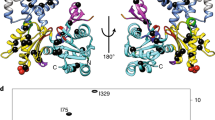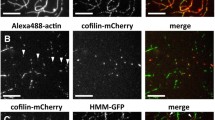Summary
Actin filaments are major dynamic components of the cytoskeleton of eukaryotic cells. Assembly of filaments from monomelic actin occurs with expenditure of energy, the tightly bound ATP being irreversibly hydrolyzed during polymerization. This dissipation of energy perturbs the laws of reversible helical polymerization defined by Oosawa and Asakura (1975), and affects the dynamics of actin filaments. We have shown that ATP hydrolysis destabilizes actin-actin interactions in the filament. The destabilization is linked to the liberation of Pi that follows cleavage of the γ-phosphate. Pi release therefore plays the role of a conformational switch. Because ATP hydrolysis is uncoupled from polymerization, the nucleotide content of the filaments changes during the polymerization process, and filaments grow with a stabilizing “cap” of terminal ADP-Pi subunits. The fact that the dynamic properties of F-actin are affected by ATP hydrolysis results in a non-linear dependence of the rate of filament elongation on monomer concentration.
Access this chapter
Tax calculation will be finalised at checkout
Purchases are for personal use only
Preview
Unable to display preview. Download preview PDF.
Similar content being viewed by others
References
Bigay, J., Deterre, P., Pfister, C., and Chabre, M., 1987, Fluoride complexes of aluminium or beryllium act on G-proteins as reversibly bound analogues of the γ-phosphate of GTP, EMBO J. 6: 2907.
Carlier, M.-F., 1987, Measurement of Pi dissociation from actin filaments following ATP hydrolysis using an enzyme-linked assay. Biochem. Biophys. Res. Comm. 143: 1069.
Carlier, M.-F., Pantaloni, D., and Korn, E.D., 1984, Evidence for an ATP cap at the ends of actin filaments and its regulation of the F-actin steady state, J. Biol. Chem. 259: 9983.
Carlier, M.-F., Pantaloni, D., and Korn, E.D., 1985, Polymerization of ADP-actin and ATP-actin under sonication and characteristics of the ATP-actin equilibrium polymer, J. Biol. Chem. 260: 6565.
Carlier, M.-F., and Pantaloni, D., 1986, Kinetic evidence for F-ADP-Pi as a major transient in polymerization of ATP-actin, Biochemistry 25: 7789.
Carlier, M.-F., Pantaloni, D., and Korn, E.D., 1986, The effects of Mg2+ at the high-affinity and low-affinity sites on the polymerization of actin and associated ATP hydrolysis, J. Biol Chem. 261: 10785.
Carlier, M.-F., Pantaloni, D., and Korn, E.D., 1987, The mechanisms of ATP hydrolysis accompanying the polymerization of Mg-actin and Ca-actin, J. Biol. Chem. 262: 3052.
Carlier, M.-F., Pantaloni, D., Evans, J.A., Lambooy, P.K., Korn, E.D., and Webb, M.R., 1987, The hydrolysis of ATP that accompanies actin polymerization is essentially irreversible, FEBS Lett. 235: 211.
Carlier, M.-F., and Pantaloni, D., 1988, Binding of Pi to F-ADP-actin and characterization of the F-ADP-Pi filament, J. Biol. Chem. 263: 817.
Carlier, M.-F., 1989, Role of nucleotide hydrolysis in the dynamics of actin filaments and microtubules, Int. Rev. Cytol. 115: 139.
Carlier, M.-F., 1991, Actin: protein structure and filament dynamics, J. Biol. Chem. 266: 1.
Chaussepied, P., and Kasprzak, A.A. 1989, Isolation and characterization of the G-actin-myosin head complex, Nature 342: 950.
Combeau, C., and Carlier, M.-F., 1988, Probing the mechanism of ATP hydrolysis on F-actin using vanadate and the structural analogs of phosphate BeF3 - and A1F4 -, J. Biol. Chem. 263: 17429.
Combeau, C., and Carlier, M.-F., 1989, Characterization of the aluminium and beryllium fluoride species bound to F-actin and microtubules at the site of the γ-phosphate of the nucleotide, J. Biol. Chem. 264: 19017.
Combeau, C., Didry, D., and Carlier, M.-F., 1992, Interaction between G-actin and myosin subfragment-1 probed by covalent crosslinking, J. Biol. Chem. 267: 14038.
Dupuis, A., Israel, J.-P., and Vignais, P.V., 1989, Direct identification of the fluoroalumnate and fluoroberyl late species responsible for inhibition of the mitochondrial F1-ATPase, FEBS Lett. 255: 47.
Elzinga, M., and Phelan, J.J., 1984, F-actin is intermolecularly crosslinked by NN’phenylenedimaleimide through lysine 191 and cysteine 374. Proc. Nat. Acad. Sci. USA 81: 6599.
Fievez, S., and Carlier, M.-F., 1993, Conformational changes in subdomain-2 of G-actin upon polymerization into F-actin and upon binding myosin subfragment-1, FEBS Lett. 316: 186.
Goodno, C.C., 1979, Inhibition of myosin ATPase by vanadate ion. Proc. Natl. Acad. Sci. USA 76: 2620.
Hibberd, M.G., and Trentham, D.R., 1986, Relationships between chemical and mechanical events during muscular contraction. A. Rev. Biophys. Chem. 15: 119.
Kabsch, W., Mannherz, H.G., Suck, D., Pai, E.F., and Holmes, K.C., 1990, Atomic structure of the actin: DNase I complex. Nature Lond. 347: 37.
Korn, E.D., Carlier, M.-F., and Pantaloni, D., 1987, Actin polymerization and ATP hdyrolysis. Science, Wash. 238: 638.
Miller, L., Phillips, M., and Reisler, E., 1988, Polymerization of G-actin by myosin subfragment-1, J. Biol. Chem.. 263: 1996.
Milligan, R.A., Whittaker, M., and Safer, D., 1990, Molecular structure of F-actin and location of surface binding sites, Nature 248: 217.
Mornet, D., Bertrand, R., Pantel, P., Audemard, E., and Kassab, R. 1981, Structure of the actin-myosin interface, Nature 292: 301.
Oosawa, F., and Asakura, S., 1975, Thermodynamics of the polymerization of protein, Academic Press, London.
Orlova, A., and Egelman, E.H., 1992, Structural basis for the destabilization of F-actin by phosphate release following ATP hydrolysis, J. Mol. Biol. 227: 104
Pantaloni, D., Carlier, M.-F., Coué, M., Lal, A.A., Brenner, S.L., and Korn, E.D., 1984, The critical concentration of actin in the presence of ATP increases with the number of filaments and approaches the critical concentration of ADP-actin, J. Biol Chem., 259: 6274.
Phan, B., and Reisler, E., 1992, Inhibition of myosin ATPase by beryllium fluoride, Biochemistry 31: 4787.
Valentin-Ranc, C., and Carlier, M.-F., 1989, Evidence for the direct interaction between tightly bound divalent metal ion and ATP on actin. Binding of the A isomers of βγ-bidentate CrATP to actin. J. Biol. Chem. 264: 20871.
Valentin-Ranc, C., and Carlier, M.-F., 1991, Role of ATP-bound divalent metal ion in the conformation and function of actin. J. Biol. Chem. 266: 7668.
Valentin-Ranc, C., and Carlier, M.-F., 1992, Characterization of oligomers as kinetic intermediates in myosin subfragment-1 induced polymerization of G-actin, J. Biol. Chem. 267: 21543.
Valentin-Ranc, C., Combeau, C., Carlier, M.-F., and Pantaloni, D., 1991, Myosin subfragment-1 interacts with two G-actin molecules in the absence of ATP. J. Biol. Chem. 266: 17872.
Author information
Authors and Affiliations
Editor information
Editors and Affiliations
Rights and permissions
Copyright information
© 1994 Springer Science+Business Media New York
About this chapter
Cite this chapter
Carlier, MF., Valentin-Ranc, C., Combeau, C., Fievez, S., Pantoloni, D. (1994). Actin Polymerization: Regulation by Divalent Metal Ion and Nucleotide Binding, ATP Hydrolysis and Binding of Myosin. In: Estes, J.E., Higgins, P.J. (eds) Actin. Advances in Experimental Medicine and Biology, vol 358. Springer, Boston, MA. https://doi.org/10.1007/978-1-4615-2578-3_7
Download citation
DOI: https://doi.org/10.1007/978-1-4615-2578-3_7
Publisher Name: Springer, Boston, MA
Print ISBN: 978-1-4613-6102-2
Online ISBN: 978-1-4615-2578-3
eBook Packages: Springer Book Archive




